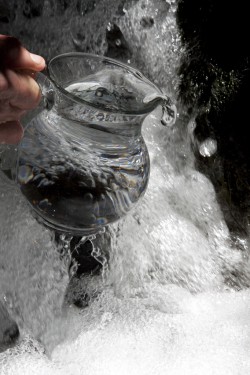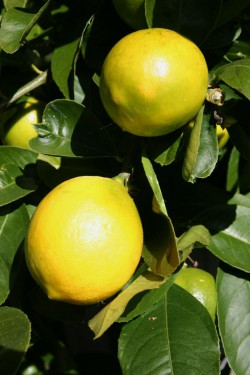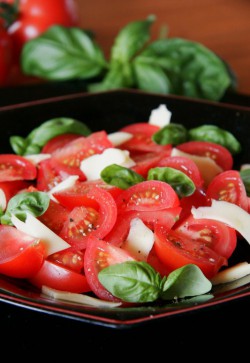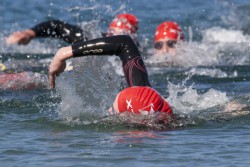|
Fitness Blog Covering Topics Of Interest Sunday, April 07 2013
Legumes play an important role in traditional diets in many parts of the world. They are low in fat, are good sources of protein and fiber, and contain a variety of micronutrients and phytoestrogens (plant estrogens). Phytoestrogens have received a lot of attention for their ability to fight not only cancer, but also heart disease and osteoporosis. They help balance hormones in the body and thus are thought to be particularly valuable for the hormone-dependent cancers: breast cancer and prostate cancer. It is well known that male hormones play a role in prostate cancer development. Despite their advantages, legumes play a minor role in most Western diets. The typical Western based diet (lower in vegetables and legumes and higher in animal-based foods) can cause an increase in both male and female hormones (androgens and estrogens), while a plant-based diet tends to lower these hormones. This is the basis for the role of diet in the development of hormone-dependent cancers. Soy foods, such as tofu, soy milk, soy beans, and vegetarian burgers, seem to be particularly rich in cancer-fighting properties. This is at least partially due to a form of phytoestrogen, called isoflavones, that is found primarily in soy. It appears to help prevent prostate cancer by binding to male hormone receptors in the prostate, thus reducing the stimulating effect of male hormones on prostate cell growth. Epidemiological studies have shown that high levels of isoflavones are often associated with low rates of breast, colon, and prostate cancer. This has been used to explain why countries such as Japan and China that typically consume large amounts of soy have lower risks of these diseases. The difficulty with consuming soy for reducing risk of prostate cancer is the lack of clinical trial evidence to support its use. As with any dietary component, it is difficult to isolate the effect of a particular food type to prove its effectiveness. One prospective study, including over 12,000 men, did evaluate consumption of soy milk. It found that those who drank soy milk regularly had a reduced risk of prostate cancer. The relationship held up after other factors were controlled for. Other studies need to be done to further establish the benefits of soy. In the meantime, getting more soy foods into your diet can be healthy for many reasons, and lowering your risk of prostate cancer may be one of these. Wednesday, January 23 2013
Remember when a total cholesterol reading of under 200 was the standard for judging cardiovascular health? Today, of course, we know that it's the components of cholesterol (LDL, HDL, the size of those cholesterol particles, and triglycerides) that are much more predictive of heart health. Well, our understanding of total weight and its effects upon your heart has evolved in similar fashion. It's not your total weight but the characteristics of that weight—how much is fat and where it's deposited—that matter most.
Surprised? Thank the scientists at the Mayo Clinic, who are behind this recent discovery. After comparing various health markers with the weights and body mass index numbers of thousands of adults, they found that more than half of those with normal weights and BMIs actually had "high body-fat percentages as well as heart and metabolic disturbances." In other words, they had the same risks of coronary disease, diabetes, and other chronic illness as people who weighed much more. This research, and its sobering implications for millions of Americans, led to the establishment of a new condition called normal weight obesity (NWO). This is more than just the latest fat phobia. It's worth paying attention to because the accumulation of fat in the body, especially in the belly and around internal organs, causes low-level inflammation that gradually damages tissue and blood vessels. (Think of it as metabolic rust.) So even though your weight or BMI may be within acceptable limits for your height and age, don't be lulled into a false sense of security. Do your own analysis, starting with these steps: 1. Stop being preoccupied with pounds. As with total cholesterol, total weight is just one general assessment of your health. Yes, people who are trying to lose weight are more likely to succeed if they weigh themselves often. But seeing numbers that are within a healthy BMI range may actually disguise your heart disease risk. Keep them in perspective. 2. Measure your body fat. For a quick estimate of this key factor, wrap a cloth measuring tape around your naked waist just above your belly button. If your weight is fairly normal but the number you see above your navel is 35 inches or more (40+ inches for men), you may have NWO. For a more exact reading, ask your doctor (or health club) to measure your body fat. This can be done using a variety of noninvasive methods. If it's higher than 30 percent (20 percent for men), you likely have NWO. 3. Get a blood test. Ask your doctor to order a thorough blood analysis at your next physical. Warning signs of NWO include low HDL (total cholesterol and LDL may be normal), along with elevated triglycerides, blood sugar, and blood pressure. 4. Target belly fat. If you're diagnosed with NWO, take aim at visceral fat. Despite how entrenched it may seem, you can lose it. The keys are: Avoid the white stuff (white bread, rice, pasta, and other refined carbohydrates). Add monounsaturated fats, which target belly fat, to your diet. And do interval exercises to burn more fat and strength-training to build lean body mass. 5. Keep tracking fat. Just as you hop on the scale to keep tabs on your weight, do the same with your body fat. Have it measured periodically at your doctor's office or health club. Or just observe the notches where your belt buckles. Conversely, if you're considered overweight by current standards, there may be some good news here. If your body-fat percentage is lower than 30 percent (20 percent for men) and your blood chemistry is normal, then you are among the "fat and fit." (Many athletes are in this category.) Continue to eat smart and exercise, but accept your body for what it is and know you're not unhealthy because of it. Feeling fat and feeling healthy are no longer mutually exclusive. More Heart-Healthy AdviceStaying hydrated is one simple way to keep blood pressure in the safe zone.Friday, September 28 2012
Disability - fibre and constipation Some people with disabilities suffer from constipation. Contributing factors can include the medications that they may take, low levels of physical activity, insufficient fluids and a diet that may be too low in fibre. Increasing the amount of fibre in the diet not only treats constipation but also lowers cholesterol, may reduce the risk of various cancers and bowel diseases, and improves general health and well-being
Fibre keeps the digestive system healthy
Fluid is also important
How much fibre?
General cautions
Things to remember
Saturday, September 22 2012
No special diet or ‘miracle food’ can cure arthritis, but some conditions may be helped by avoiding or including certain foods or supplements. Arthritis is a general term describing over 100 different conditions that cause pain, stiffness and (often) inflammation in one or more joints. Everyone with arthritis can benefit from eating a healthy, well-balanced diet to maintain general good health.
Dietary modification for gout
Omega-3 fats and Inflammation
It is important not to confuse fish oils with fish liver oils (such as cod liver oil and halibut liver oil). Fish liver oils also contain vitamin A. Large amounts of vitamin A can cause serious side effects. Ask your doctor before taking any supplements, to ensure the correct dosage.
Things to remember
Saturday, July 28 2012
 © Betty Shepherd
When you decide on your favorite summer workouts—we discussed a few fun options in Part I—you can move on to organize everything so you stay healthy and well-hydrated during your fitness routine. First of all, add extra care to how you prepare for your workouts. Make sure you are properly hydrated beforehand. Drink small amounts of water frequently, beginning two hours before you go out. I would not necessarily drink too much for 20 to 30 minutes prior to your start, though, because it can make you need to “go” while working out. If you plan to work out for more than one hour, you might want to run with a water bottle belt, as many athletes do. You also could leave one or more water bottles on the course. If you decide on that strategy, it is best to stay on a loop course. This gives you a chance to replenish every few miles. And, if you want to be absolutely safe, ask a friend to join you on a bike. For bikers, use both your water bottles, and stay ahead of the game by stopping at any convenience store or gasoline station to fill-up your bottles before you need them again. Listen to Your Body, Stay HealthyNothing is more important than listening to your body. If you do not feel well, please be very cautious. Before, during, and after your workouts, the first signs of a possible problem might be heavier breathing, an elevated heart rate, or losing concentration. Consider wearing a heart rate monitor—it can caution you before you run into trouble. When you feel unwell, admit it to yourself early on and get out of the heat right away. Cool off with a cold towel, use ice cubes, and hydrate! Please, do not wait to see a physician if you do not feel better immediately. Be familiar with some of the early warning signs of overheating: dizziness, fainting, fatigue, hot skin and followed by chills, lack of perspiration, feeling thirsty, and elevated heart rate. If you stop sweating, you most likely are very dehydrated(1). Also be careful after your workout. Take a dry shirt to put on after your run, and always take some fluid to drink. If you feel cold—even in summer, for example when you come from outside into an air-conditioned room while still wearing your wet workout clothes—change immediately into dry clothes. It may be summer, but you need to stay “warm” after your workouts to avoid weakening your immune system and maybe getting a cold. For adequate protection, sunscreen, glasses, a summer hat, and a rain jacket are always good to have close by. Hydrate Well Throughout the Day © Betty Shepherd It can be very warm and dry during the summer, so make sure you stay cool and hydrated at all times. There are some guidelines I would suggest, and one of my favorite is to keep a bottle of water or a sports drink close by. This will remind you to drink and get replenished with small amounts continuously and evenly spread out throughout the day. Hydration is critical for many body functions, such as digestion, regulation of body temperature, and the circulatory processes that bring nutrients to the cells and transport waste from them. This is even more understandable when considering that our bodies are up to 75% water in total, depending on age and build, with blood being 83% water and the brain being 75 to 78% water. These are the levels when each of those organs work best(2). When you get dehydrated, every cell in your body suffers, causing you to feel less fit and fatigued(3). This puts more stress on your body and makes you more prone to illness and disease. And you can be at risk of overheating, which can have terribly serious consequences—including being life-threatening. For proper hydration, start with juice from a fresh squeezed lemon with lots of water first thing in the morning. It is good for re-hydration after your night’s sleep and also will help your body to detoxify. And as mentioned earlier, drink enough before, if possible during, and right after your training. It is best to replenish within 30 minutes of finishing your workout—the so-called “recovery window.” I like to eat a big slice of water melon right after my training, it is a great source of water, antioxidants, and easily digested carbohydrates. In the following article “General Guidelines,” you can find more information on this topic. A Few Thoughts on Summer Nutrition © Betty Shepherd Many people like to adjust their nutrition and take advantage of everything that is fresh and more available in the summer, like tasty fruits and vegetables. It is berry season—maybe you are lucky enough to be able to pick your own on a berry farm. Eat food that has high water content like melon, citrus fruits, berries, and vegetables. Diluted fruit juices with 1 part juice and up to 2 parts water can help you to stay hydrated. The juice from sour cherries, for example, has many health benefits and can even support faster strength recovery for runners. You also can try the many different kinds of unsweetened iced teas. My favorite flavor is mango. Enjoy what you eat and make it tasty. Add some cool summer nutrition like different kinds of smoothies. Depending on the amount you make, they even can be served as an entire meal. Just add water, berries (like raspberries and blueberries), banana, whey protein, and some ice cubes into a blender. Mix it and enjoy. Or try a variation with mango or pineapple. And for more health benefits, add a teaspoon of ground flaxseeds. There also are many delicious salad creations with great dressings. You could try a variety of citrus dressings. Other choices of salads include my favorites—fresh cucumber salad with dill and onions or a tomato salad with olives, feta, and basil. Sashimi and sushi can be delightful lighter dinner fare when well-portioned. And when you prepare your meals, add more vegetables than pasta or potatoes. And how about cold summer soups like water cress and gazpacho? And for all you BBQ lovers, here are some thoughts on “Healthier Grilling.” I hope you can enjoy many relaxing summer evenings with your family and friends. Good luck for your summertime fitness!
Sunday, June 10 2012
 © Betty Shepherd Summer is such a beautiful time of the year. Happy days with stunning sunrises, long, warm evenings and relaxing afternoons freshened up with lemonade and watermelon. Even on hot days, it is not difficult to find great exercises to keep your fitness level up. Summer is also special because you can finally do the workouts you might have been missing during the colder months of the year. You even can take advantage of the training sessions you would not necessarily do during the ideal training period for other sports in winter. You can add cross-training, as well. That means you can work out in other sports or add exercises that support what you normally focus on. It gives you an opportunity to prepare yourself for your upcoming autumn events or improve your fitness and skills for your favorite winter sports. Cross-training can give you a wide variety of workout choices which can enable you to reach your goals. In the summer, you have a wonderful opportunity to take advantage of the outdoors and experience beautiful connections to nature—the oceans, lakes, rivers, beaches, mountains, and shady woods and forests. Before we go on, however, I would advise getting a physical before you start your summertime fitness, making sure you are fit enough to work out in those warm conditions and are able to stay ahead of the game. It is a time that is good for more than just goal setting. You also can talk about your fitness ideas and workout possibilities for the upcoming months and decide if they are realistic for you. Your Favorite Summer WorkoutsOf course, in summer—as well as year-round—do activities you enjoy. They might include your favorite ball game, long hikes, water sports, or anything that is giving you excitement and happiness while exercising. Maybe you have some “wishes” you can turn into goals—like improving your fitness, learning to surf, running your first 5K, hiking a mountain, or biking some new trails by the end of the warmest time of the year. When you follow a path of realistic and achievable short-term goals, it can be much easier to stay motivated and make it fun to reach your goal.  © Betty Shepherd It always is a good idea to include your favorite workouts first, then, integrate new opportunities as the summer progresses. By the end of the warmest months, you will have explored and tried different exercises—alternatives you may have been curious about, perhaps, and had thought could be fun for you. Ball games, swimming, water sports, mountain biking, running, hiking, camping, for example, all are great exercises to try during the summer, especially if you had never done so before or if it had been a long time since you did them. And if you are ready to take on multiple challenges, nothing might be better than combining a number of activities. My favorite summer workouts are those easy and relaxing evening runs, when the sun starts to set and the air is getting fresher, when I can play with those long shadows in the forest. I often combine them with a swim, diving into a lake after my run. Sometimes I jog a few miles to a beach by a lake and cool-off by swimming for some distance, depending on how I feel after my run. I used to do this often as a kid and later during my track season. I have enjoyed it ever since. As the previous comment illustrates, summer workouts are a great way of rekindling happy childhood memories: those long days of carefree summer vacations from school, playing baseball, basketball, or soccer, or maybe completing a track session in the stadium. Perhaps you have a loving memory of the smell of freshly cut grass. That wonderfully distinctive aroma always reminds me of the newly-mown infield at the local track when I was a kid. During the warmest time of the year, it is best to wait for temperatures to have fallen in the early morning or the late evening. Any kind of ball game—basketball, baseball, soccer, or tennis—is fun to play in the cooler evenings. With dusk still far away, you can arrange to get together with your friends after work and add informal versions of these games to your other activities. This can be fun and often makes it easier to stay fit. When I was growing up and started running, we played lots of ball games as warm-ups for our training sessions. A game of team handball or volleyball was just right for us kids. Coming from Germany, soccer always was the favorite. Maybe you can join a group of friends to play a game? You will soon find the countless sprints to get the ball or trying to keep it will definitely give you good cardiovascular exercise. Huffing and puffing, I sometimes had to stop running to catch my breath. For many of us, nothing is nicer than taking part in summer water sports. You can enjoy the whole day at a lake or the ocean with activities such as paddle boarding, kayaking, surfing, snorkeling, or playing different water ball games with your friends. These all are sports that can provide fun activities for you and your entire family. If you don’t have the luxury of a few free days, try a nice swim before or after work, or, if time permits, during your lunch break. Swimming is not only a great cardiovascular workout, and refreshing during the summer months, it also can help you recover from more strenuous training like biking or running. And, at the same time, it will improve deeper breathing.  Dave enjoys kayaking across the state of Florida. © Dave Bracknell A former client of mine started with a few sprint triathlons in the summer and quickly moved up to the Olympic distance in winter. He later discovered that kayaking would be fun for him, too. I got an email message from him with breathtaking photos of the ocean and his kayak resting on a beach. He wrote that he just kayaked across the state of Florida in a charity event. I can imagine that he had a fun pool party afterwards! It is a great idea to start a party with your family and friends in late afternoon, playing ball and enjoying swim games, and later taking in the sunset while having a super-tasty barbecue. Could an interesting hike become one of your favorite workouts? Even a leisurely “glow worm and fire flies” hike on a cool summer night might be something you would enjoy. It can be such a fun activity for the whole family. And if you choose a long day hike, you might want to top it off by camping out overnight under the stars. Change the Venue, Adjust Your Goals, and Explore Cross-TrainingSure, you want to avoid the hottest part of the day—so go inside! Join a gym for the warmest months, and instead of running or biking outside, try the treadmill or the stationary bike or one of the many other aerobic exercise machines available at most gyms. You always can exercise outside during the cooler temperatures around sunrise and sunset. The nice thing about summer events is that most of them take place in the morning or evening hours. Nothing is better than completing your workout or event and meeting friends for a late breakfast afterwards. “It’s just a piece of pancake!” Adjust your fitness goals for the warmest time of the year. As always, it is best to set realistic, achievable, short-term goals. I recommend focusing on a few shorter workouts with higher intensity and playful variations in speed. Perhaps your goal might be to become faster in your sport during the summer. Then in autumn, you can add some endurance and focus on longer events again. Once you accomplish your summer goals, you can use your improved fitness to achieve great results in your events later in the year.  © Betty Shepherd Here are some ideas. If you are a triathlete, you might want to improve one of your disciplines to be better prepared for competition in the fall. To work on your swimming might be a good idea. Or you might change from running to more biking, and in the colder months add longer running workouts again. There are great duathlon competitions in the summer. To work on improving your speed, you may decide to prepare for a sprint triathlon or a sprint duathlon, instead of the longer versions. Many runners may just have finished a spring marathon. The warm summer months are ideal to prepare for a 5K, and in late August one could prepare for a 10K. Then, in September, you can get ready for a half marathon. All the training and goal setting can be done with the ultimate aim of a faster marathon. Or simply enjoy the shorter distances as your main event all summer. That is good, too! You also can switch from one sport to another. Think “off season training.” For runners, bike and swim instead of doing high mileage running. Some bikers go from the road into the forest and mountain bike, it is a great way to improve your skills. Enjoy water sports like kayaking or paddle boarding. Compete in team swimming events, relays are always great fun. A good goal could be to work on other elements of fitness, like strength or technique training, especially if these are areas in which you already want to improve. To do this, you may want to include these new elements in your routine during the summer so you are better prepared for your upcoming events later in the year. I love these elements of cross-training. They can give you a chance to try out a variety of workouts—not doing the same activity every day. And they can be done indoors during the warmest hours of the day. Think about it as something you can look forward to complement your training. Deep-water running, core strengthening, light weights, stretching and yoga… they all can be added to your summertime fitness routine. In this manner, you can condition your body for your fall events—to be a better runner, biker, or golfer—and for your winter sports to be a stronger skier, snowboarder, or skater. Be prepared to adjust your workouts according to the weather conditions on any given day. It can be hot, humid or rainy, and setting a new and easier goal will help you achieve them. Maybe you, too, would love to combine some of your runs with a cooling swim afterwards. And finally, a general suggestion for your summer workouts: start them slowly, increasing your workload in gentle increments. The weather conditions can be challenging and even deceptive. By starting your workouts carefully, keeping your strength in reserve, you will be able to keep your body temperature and your pulse lower. And you will not get so fatigued. In many climates, temperatures can change dramatically over the course of the day, so always be aware of the conditions in which you do your activities and training. Of course, during summer months, adequate hydration should always be on your mind. Fitness Programs and Sport Events You Can JoinCheck out recreational leagues and programs for adults and kids in your area. Your town, local fitness club, and local businesses might offer programs for many sports and events, and maybe you would like to join one of them. This way you also might meet new friends and enjoy staying fit together. It might even not feel like working out hard at all. There are many events over the summer that may be of interest to you. Some of them are charity rides or runs where you also can get the satisfaction of helping your community or a charity that touches your heart like SOS Outreach with which Take The Magic Step is a partner. In “Summertime Fitness: Part II,” I will explore proper hydration and offer a few thoughts on summer nutrition. Until then, I hope you can enjoy your fun and cool summertime fitness!
Sunday, February 26 2012
First off, this type of headache, prompted by exercise, is called an "exertional headache" or "exercise headache." Running is known to cause exertional headaches, and lifting weights is another common cause. Generally, exercise headaches cause pain (lasting from 5 minutes - 2 days) on both sides of the head. They may even cause nausea.
What might be contributing factors? -Hot weather -High altitude -Caffeine -Alcohol -Dehydration How serious is this? -You should know that, while they can be very irritating, these headaches are not medically serious. -However, these headaches still should be properly diagnosed, as they could possibly be a sign of something serious (potentially bleeding in the brain). In fact, over 10% of people with exercise headaches may have a serious underlying condition, so you should talk to your doctor...especially if you've never had a headache like this before. -It is probably nothing serious if the headache leaves within a few hours and there are no other neurological symptoms -A doctor might recommend a MRI exam if your headaches do last longer than a few hours, if they begin very suddenly, if you are older than 40, and if you have accompanying symptoms (including nausea). This MRI will help the doctor to verify that there is no serious underlying issue. How can I treat this? -Normally, these headaches leave on their own. -If treatment is necessary, the medication "indomethacin" may be helpful. -Aspirin and ibuprofen may also be effective. -Actually exercising regularly can help to prevent exercise headaches (funny as that sounds!), although it may be best to avoid the specific circumstances in which your headaches tend to arise. Tuesday, January 03 2012
Monday, June 20 2011
Why should we be drinking water?.
Weight Loss Water is one of the best tools for weight loss, first of all because it often replaces high-calorie drinks like cola, juice and alcohol with a drink that doesn't have calories. But it's also a good appetite suppressant and often when we think we're hungry, we're actually just thirsty. Water has no fat, no calories, no carbs, no sugar. Heart Healthy Drinking a good amount of water could lower your risks of a heart attack. A six year study published in the American Journal of Epidemiology found that those who drink more than 5 glasses of water a day were 41% less likely to die from a heart attack during the study period than those who drank less than two glasses. Energy Being dehydrated can sap your energy and make you feel tired – even mild dehydration o as little as 1 or 2% of your body weight. If you're thirsty you're already dehydrated and this can lead to fatigue, muscle weakness, dizziness and other symptoms. Headache Cure Another symptom of dehydration is headaches. In fact, often when we have headaches it's simply a matter of not drinking enough water. There are lots of other causes of headaches of course, but dehydration is a common one. Healthy Skin Drinking water can clear up your skin and people often report a healthy glow after drinking water. It won't happen overnight, of course, but just a week of drinking a healthy amount of water can have good effects on your skin. Drinking water also helps to limit stretch marks during weight loss and pregnancy. Digestive Problems Our digestive systems need a good amount of water to digest properly. Often water can help cure stomach acid problems and water along with fibre can cure constipation – often a result of dehydration. Cleansing Water is used by the body to help flush out toxins and waste products from the body. Cancer Risk Related to the digestive system, drinking a healthy amount of water has also been found to reduce the risk of colon cancer by 45%. Drinking lots of water can also reduce the risk of bladder cancer by 50% and potentially reduce the risk of breast cancer. Better Exercise Being hydrated can severely hamper your exercise activities, slowing you down and making it harder to do aerobics and to lift weights. Exercise requires additional water, so hydrate yourself before, during and after exercise. How To Form The Water Habit Here are some tips that have helped me. How Much Water? As a rule of thumb 2l of water per day and if exercising 2.5l of water. It's not good to drink water when you're thirsty as you're already dehydrated by then. Best is to form a routine: drink a glass when you wake up, a glass with each meal, a glass in between meals, and also drink before, during and after exercise. Try to generally keep yourself from getting thirsty. Carry A Bottle A lot of people find it useful to carry a plastic drinking bottle, fill it with water, and carry it around all day. When it's empty, fil it up again and keep drinking. Set A Reminder Set your watch to beep at the top of each hour, or set a periodic computer reminder, so that you don't forget to drink water. Substitute With Water If you normally get a cola, or an alcoholic beverage, get a glass of water instead. Try sparkling water instead of alcohol at social functions. Exercise Exercising can help make you want to drink water more. It's not necessary to drink sports drinks like Lucosade when you exercise, unless you're doing it for more than an hour. Just drink water. If you're going to exercise, be sure to drink water a couple of hours ahead of time, so that it will get through your system in time, and again, drink during and after exercise as well. Track It It often helps, when forming a new habit to keep track of it. This increases awareness and helps to ensure that you're staying on track. Keep a little log, which can be a simple tick for each glass of water you drink. | ||||||||||||||||||||||||||||||||||||||||||||||||
 |



